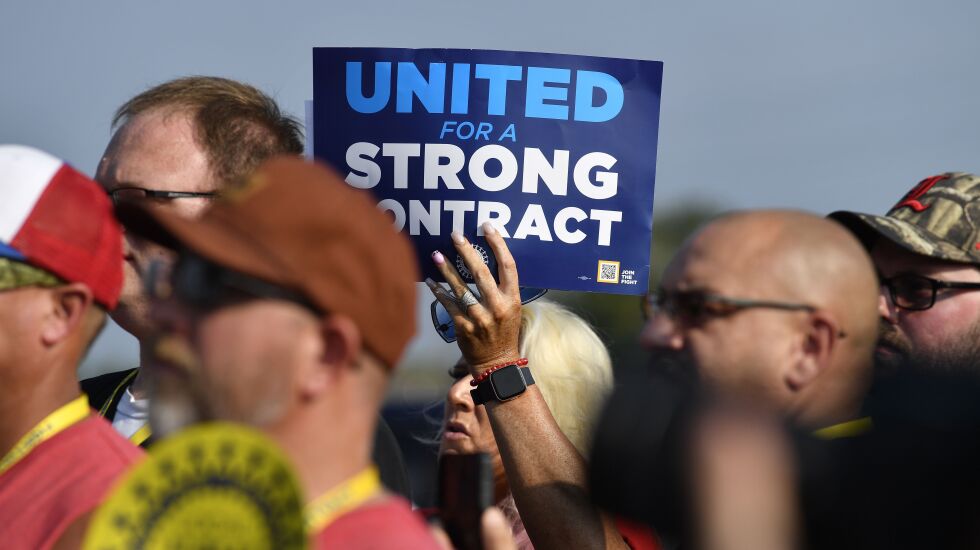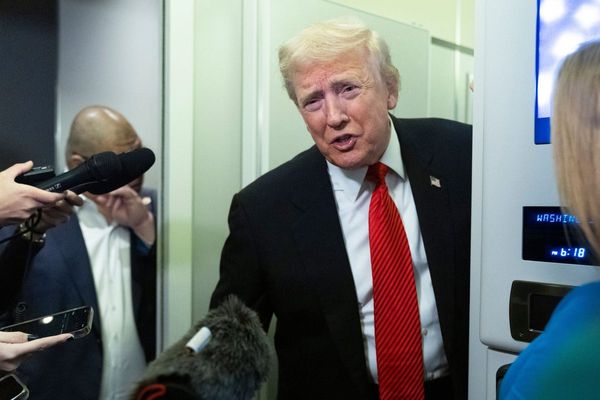
DETROIT — With just over 24 hours left before a strike deadline, United Auto Workers President Shawn Fain says offers from the companies aren’t enough and the union is getting ready to strike.
In a Facebook address to members Wednesday, Fain said General Motors, Ford and Stellantis have raised their initial wage offers, but have rejected some of the union’s other demands.
“We do not yet have offers on the table that reflect the sacrifices and contributions our members have made to these companies,” he said. “To win we’re likely going to have to take action. We are preparing to strike these companies in a way they’ve never seen before.”
The union is threatening to strike companies that haven’t reached an agreement by 10:59 p.m. CDT Thursday, when current agreements expire. It would be the first time in the union’s 80-plus-year history that it struck all three companies at the same time. The union has 146,000 members at the so-called Detroit Three automakers.
Talks continued Wednesday with the companies, but it appeared that both sides are still far apart.
Fain said without contract agreements starting Friday, the union will begin targeted strikes at locations for each of the Detroit Three. He said the strikes can be expanded depending on progress at the bargaining tables.
“We’re going to hit where we need to hit and when we need to hit, we’re going to hit to move mountains,” Fain said during a speech that drew on biblical references about the power of faith to accomplish great things.
He called the union’s plan for work stoppages “stand-up strikes,” a reference to its historic sit-down strikes of the 1930s that built UAW power.
Fain cast the fight as an epic struggle between the working class and corporate greed, with people’s wages falling behind escalating pay of CEOs and automakers choosing to lavish money on dividends and stock buybacks.
Automakers contend that they need to make huge investments to develop and build electric vehicles, while still building and engineering internal combustion vehicles. They say an expensive labor agreement could saddle them with costs, forcing them to raise prices higher than non-union foreign competitors.
Fain said the final decision on which plants to strike won’t be made until Thursday night and will be announced at 9 p.m. CDT.
It won’t be known until then whether any of the two Chicago-area Ford plants will be included in the strikes. Ford’s 99-year-old Chicago assembly plant is at 12600 S. Torrence Ave., where line workers are presented by UAW Local 551.
The local’s chairman, Alan “Coby” Millender, said most of his 5,500 workers are ready to strike. “The majority of my membership is ready and they know it’s time [to take action],” said Millender.
The UAW also has members at a stamping plant in Chicago Heights, where the workers belong to Local 588.
Striking members are eligible for $500 per week from the UAW. Strikes at individual plants would be far less costly to the union. In the case of a broad walkout against General Motors, Stellantis and Ford at the same time, the union’s $825 million strike fund would run dry in just under three months, not including payments by the union for health insurance.
On Wednesday, Fain said the companies upped their wage offers, but he still called them inadequate. Ford offered 20% over 4 1/2 years, while GM was at 18% for four years and Stellantis was at 17.5%. The raises barely make up for what he described as minimal raises of the past. In a 2019 agreement the union got 6% pay raises over four years with lump sums in some years as well as profit sharing checks.
Top pay for an assembly plant worker is now $32 per hour.
The union likely will strike at plants that make components for pickup trucks and big SUVs, which are the companies’ main profit centers, said Marick Masters, a business professor at Wayne State University in Detroit. The Torrence Avenue location could be targeted early for that reason, as it produces the expensive and profitable Ford Explorer and Lincoln Aviator SUVs.
“They’re trying to impose some hardship on the companies and apply an accelerating level of pressure to encourage them to make an offer which will be acceptable to the rank and file and goes further toward meeting the demands that they have on the table,” he said.
The UAW has a current wage demand of about 36% over the life of a four-year contract. In addition to general wage increases, the union is seeking an end to varying tiers of wages for factory jobs; a 32-hour week with 40 hours of pay; the restoration of traditional defined-benefit pensions for new hires who now receive only 401(k)-style retirement plans; and a return of cost-of-living pay raises, among other benefits.
Fain said progress has been slow in those areas. He also said the union wants the right to strike over plant closures. Another proposal would entitle workers to pay hikes each time the companies boost dividends or buy back shares.
Perhaps most important to the union is that it be allowed to represent workers at 10 electric vehicle battery factories, most of which are being built by joint ventures between automakers and South Korean battery makers. The union wants those plants to receive top UAW wages. In part, that is because workers who now make components for internal combustion engines will need a place to work as the auto industry makes the transition to electric vehicles.







